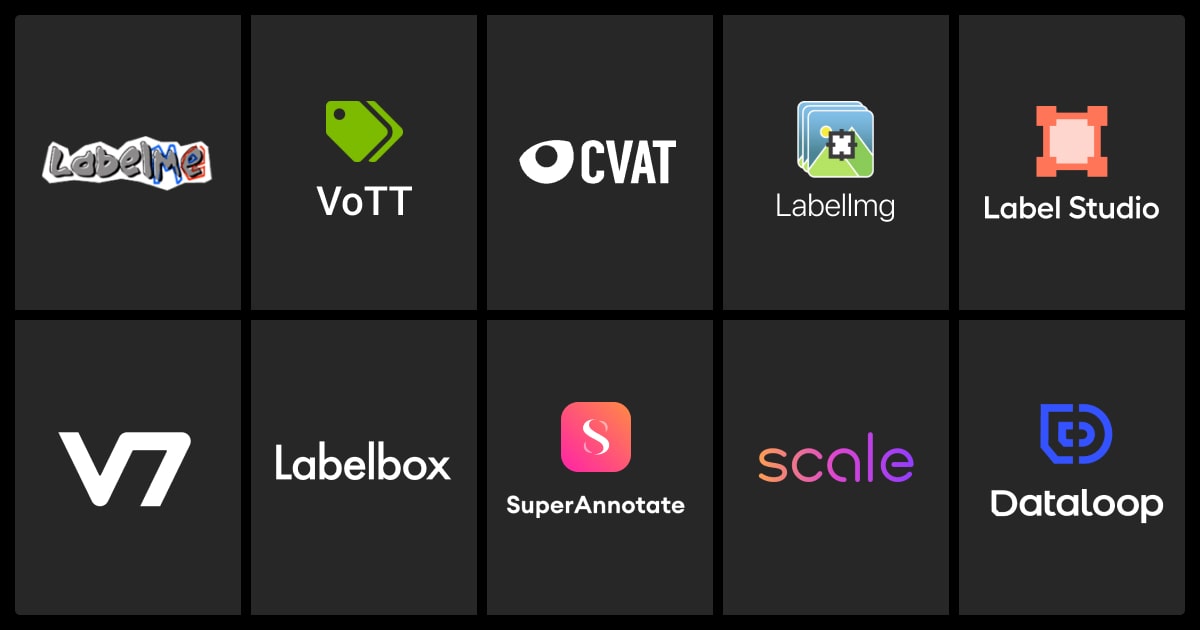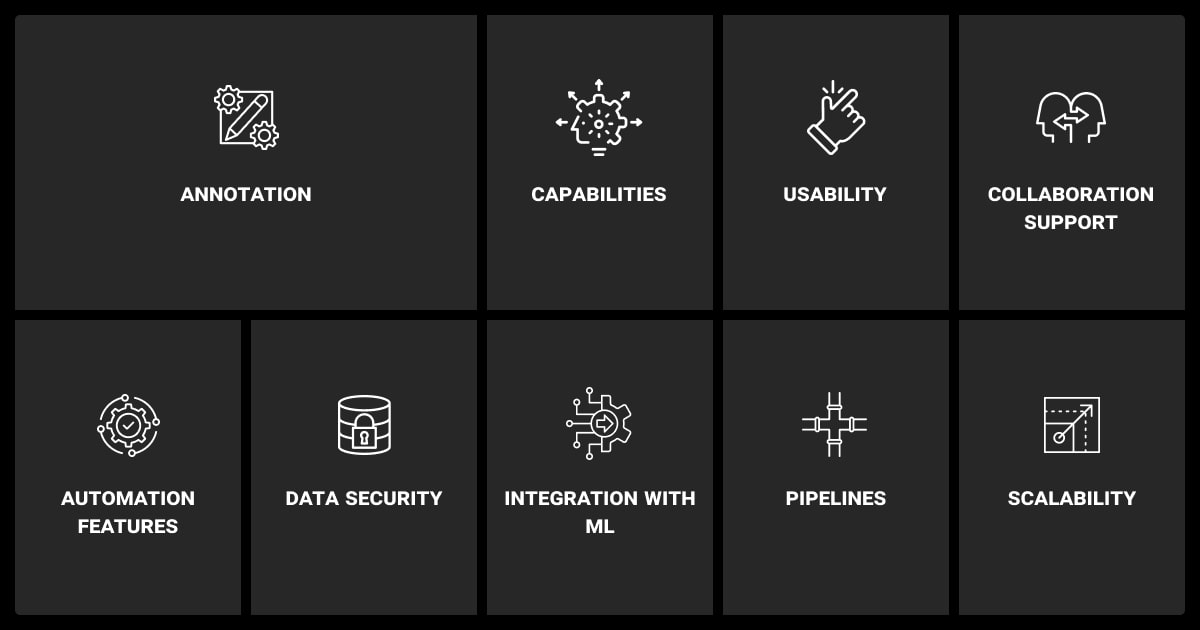Image Annotation Tools: Must-Have Picks
Table of Contents
- TL;DR
- How Image Annotation Tools Optimize Your ML Project
- Open-Source Image Annotation Tools
- Commercial Image Annotation Tools
- Comparing the Best Image Annotation Tools on the Market
- Key Features to Look for in Image Annotation Tools
- Selecting the Right Image Annotation Tool
- About Label Your Data
- FAQ

TL;DR
- Image annotation tools help create labeled datasets for training ML models.
- Support various annotation types like bounding boxes, polygons, and segmentation.
- Open-source tools like CVAT and LabelImg are cost-effective for small projects.
- Commercial platforms like Labelbox and V7 offer advanced features and scalability.
- Selecting the right tool depends on project size, annotation type, and team needs.
- Automation features in tools can save time by pre-labeling objects or detecting errors.
- Integration with machine learning pipelines ensures efficient data handling.
How Image Annotation Tools Optimize Your ML Project
Image annotation tools are essential for labeling data accurately and efficiently. They form the backbone of successful machine learning projects.
The right tool depends on your needs—simple options work for small tasks, while advanced ones tackle large, complex datasets. A poor choice can waste time, degrade model quality, or increase costs. This guide reviews open-source and commercial data annotation tools to match your project’s size, complexity, and team expertise.
These tools transform raw data into structured datasets for tasks like image recognition, object detection, and image segmentation. They streamline workflows and boost model accuracy. Here’s how they optimize your project:
- Simplify labeling: Pre-built features and automation speed up the process.
- Save time: Efficiently handle large datasets with less manual effort.
- Enhance accuracy: Deliver consistent, high-quality labels for better model performance.
- Enable scalability: Top tools adapt to growing datasets and evolving project demands.
Choose wisely to ensure your data is labeled correctly and your model performs at its peak. Adding scalability as a benefit highlights how these tools future-proof your work, making this section even stronger.

Manual Annotation vs. Image Annotation Tools
Manually labeling images might work for very small projects, but it’s impractical for larger datasets or complex tasks. In this case, you should opt for professional data annotation services (which can also work with your tools) or try using the tools yourself.
| Aspect | Manual Annotation | Annotation Tools |
| Efficiency | Time-intensive and repetitive | Faster with automation and shortcuts |
| Scalability | Difficult for large datasets | Handles thousands of images easily |
| Consistency | Prone to human error | Built-in checks reduce errors |
Annotation tools also provide features like collaboration, pre-labeling, and export options. They are crucial for team projects and machine learning pipelines. For most applications, relying on tools is the more practical and scalable choice.
Balancing manual and automated annotation is key. Automation accelerates workflows, while manual review ensures the precision needed for robust datasets.
Open-Source Image Annotation Tools
Open-source tools offer cost-effective and flexible solutions for image annotation. They are ideal for researchers, students, and small teams looking for robust features without licensing fees.
Below are some of the best options available:
LabelMe
LabelMe, developed by MIT, is a web-based annotation tool for drawing polygons around objects in images. It’s ideal for tasks like object detection and segmentation.
Key features:
- User-friendly polygon annotation interface.
- Open-access public dataset for testing and training.
- Browser-based, no installation required.
Best for: Small projects and researchers needing detailed annotations.
VoTT (Visual Object Tagging Tool)
Microsoft’s VoTT is an open-source annotation tool designed for both images and videos. It integrates with popular storage solutions and supports multiple file formats.
Key features:
- Supports bounding boxes and polygonal segmentation.
- Integrates with Azure, AWS, and local storage.
- Allows exporting annotations in formats like Pascal VOC, COCO, or YOLO.
Best for: Projects requiring easy video and image annotation workflows.
CVAT (Computer Vision Annotation Tool)
CVAT (Computer Vision Annotation Tool) CVAT stands out as a powerful open-source platform that handles both image and video annotation. Originally developed by Intel, this tool has gained significant traction in the computer vision community.
Key Features:
- Multiple annotation types including bounding boxes, polygons, and keypoints
- AI-assisted annotation capabilities
- Integration with neural networks for pre-annotation
- Support for both cloud and local deployment
- Active community and regular updates
Best For: Teams requiring a robust, free solution with advanced features. Particularly suitable for complex computer vision projects requiring various annotation types.
LabelImg
LabelImg remains a popular choice for simple object detection projects, offering a lightweight solution for basic annotation needs.
Key Features:
- Simple, focused interface
- Fast annotation for bounding boxes
- Support for PASCAL VOC format
- Cross-platform compatibility
- Open-source
Best For: Individual researchers or small teams with straightforward object detection projects.
Label Studio
Label Studio is a versatile open-source annotation tool that supports a variety of data types, including images, text, and audio. It’s highly customizable for different projects.
Key features:
- Customizable interface for specific annotation needs.
- Supports multiple formats like JSON, CSV, and COCO.
- Plugins available for advanced integrations.
Best for: Teams needing flexibility to handle diverse datasets.
Make Sense
Make Sense offers a straightforward, open-source solution for basic annotation needs.
Key Features:
- Simple, intuitive interface
- Local deployment option
- Basic annotation tools
- Format conversion utilities
- Free and open-source
Best For: Small teams or individual researchers with basic annotation needs.
These tools offer powerful capabilities without licensing costs. Ideal for researchers, startups, or anyone working on a budget.
Open-source tools like CVAT and LabelImg empower teams to take control of their annotation workflows without significant cost, making them a practical choice for small projects or early-stage startups.
Commercial Image Annotation Tools
Commercial tools provide advanced features, scalability, and support for large projects. Great for teams managing complex datasets or requiring collaboration and automation.
Here are some top options to consider:
V7
V7 is an advanced annotation platform with AI-assisted tools to speed up the labeling process. It supports images, videos, and 3D data, making it ideal for complex datasets.
Key features:
- AI-powered pre-labeling for faster annotations.
- Collaborative interface for team workflows.
- Supports 3D point clouds and volumetric data.
Best for: Large-scale and complex projects requiring advanced annotation capabilities.
Selecting an annotation tool depends on the complexity of your project. For medical imaging, platforms like V7 shine with support for unique formats like DICOM and advanced automation features.
Labelbox
Labelbox provides an all-in-one platform for annotation, data management, and collaboration. It’s designed for large-scale projects and integrates seamlessly with popular machine learning frameworks.
Key features:
- AI-assisted labeling for increased efficiency.
- Robust tools for managing datasets and workflows.
- Integration with TensorFlow, PyTorch, and other ML libraries.
Best for: Enterprises and teams handling large datasets with collaborative needs.
SuperAnnotate
SuperAnnotate combines automated pre-annotations with real-time collaboration features. It supports 2D, 3D, and text annotation, offering versatility for a wide range of data types.
Key features:
- Advanced annotation tools for 2D and 3D datasets.
- Collaborative workspace with quality assurance features.
- Automated workflows to streamline labeling tasks.
Best for: Teams working on diverse datasets and requiring real-time collaboration.
Scale AI
Scale AI specializes in providing high-quality annotations using a blend of machine learning and human input. It’s tailored for large projects and offers rapid turnaround times.
Key features:
- Scalable annotation services for large datasets.
- Quality assurance through a mix of automation and human reviewers.
- Support for various industries, including automotive and retail.
Best for: High-volume projects needing precise and fast annotations.
Dataloop
Dataloop is a comprehensive platform with AI-assisted annotation tools and integrated dataset management. It supports images, videos, and audio data, making it a flexible choice for multimedia projects.
Key features:
- Built-in models for automated labeling.
- Dataset management tools for organizing large-scale projects.
- Real-time collaboration for distributed teams.
Best for: Teams managing multimedia datasets with diverse labeling requirements.
Supervisely
Supervisely provides a comprehensive platform combining annotation tools with model training capabilities.
Key Features:
- Integrated development environment
- Neural network integration
- Extensive collaboration features
- Custom plugin support
- Deep learning tools
Best For: Teams looking for an end-to-end solution from annotation to model training.
Roboflow
Roboflow focuses on streamlining the entire computer vision pipeline, from annotation to model deployment.
Key Features:
- Dataset management tools
- Model training integration
- Automated data augmentation
- Version control for datasets
- Export to multiple formats
Best For: Teams looking for a unified platform for both annotation and model development.
Datature
Datature combines annotation capabilities with model training in a unified platform.
Key Features:
- Integrated model training
- Collaborative annotation
- Version control
- Export flexibility
- Model deployment options
Best For: Teams looking to combine annotation and model development in one platform.
Commercial tools are suitable for larger or more complex projects. In the next section, we’ll focus on how to evaluate these tools and decide which one fits your needs.
The right image annotation tool isn’t just about functionality; it’s about aligning with your project’s scale, team dynamics, and quality requirements. Tools like Labelbox or SuperAnnotate ensure precision and efficiency in even the most demanding tasks.
Comparing the Best Image Annotation Tools on the Market
Here’s a quick comparison of top image annotation tools to help you choose the best fit:
| Tool Name | Type | Key Features | Best For |
| LabelMe | Open-Source | Polygon annotations, browser-based | Small projects, detailed annotations |
| VoTT | Open-Source | Bounding boxes, video support, exports | Easy image/video workflows |
| CVAT | Open-Source | Bounding boxes, AI-assisted, cloud/local | Complex projects, advanced features |
| LabelImg | Open-Source | Lightweight, bounding boxes, VOC format | Simple object detection, small teams |
| Label Studio | Open-Source | Customizable, multi-format, plugins | Diverse dataset flexibility |
| Make Sense | Open-Source | Simple UI, local, basic tools | Basic annotations, small teams |
| V7 | Commercial | AI pre-labeling, 3D support, collaboration | Large-scale, complex projects |
| Labelbox | Commercial | AI-assisted, workflow management | Enterprises, large datasets |
| SuperAnnotate | Commercial | 2D/3D annotations, QA, real-time collab | Diverse datasets, collaboration |
| Scale AI | Commercial | Scalable, automation, human review | High-volume, precise annotations |
| Dataloop | Commercial | AI labeling, multimedia support | Multimedia dataset management |
| Supervisely | Commercial | Annotation + training, deep learning | End-to-end annotation-to-model |
| Roboflow | Commercial | Dataset mgmt, augmentation, training | Unified annotation + development |
| Datature | Commercial | Collaborative, training, flexible exports | Annotation + model development |
Key Features to Look for in Image Annotation Tools

Here are the essential features to look for when choosing a tool for image annotation:
Annotation Capabilities
The tool you choose should support the types of data annotation your project requires. Some common capabilities include:
- Bounding boxes: Best for object detection.
- Polygons: For irregular shapes like roads or buildings.
- Semantic segmentation: Assigning pixel-level labels for detailed analysis.
- Key points: Marking specific features like facial landmarks.
- 3D cuboids: Adding depth information for applications like autonomous vehicles.
Some tools also support specialized tasks like geospatial annotation, which is critical for applications such as urban planning and environmental monitoring.
Usability
A user-friendly interface saves time and reduces the learning curve for your team. Look for:
- Intuitive design: Clear menus, drag-and-drop features, and customizable layouts.
- Shortcut keys: To speed up repetitive tasks.
- Documentation and tutorials: Helpful for onboarding new team members quickly.
Collaboration Support
If your team is distributed or working on large datasets, collaboration features are crucial. Key features include:
- Multi-user access: Allowing multiple annotators to work simultaneously.
- Role-based management: Assigning permissions for annotators, reviewers, and admins.
- Review workflows: Enabling quality checks and approvals within the platform.
Automation Features
Modern tools integrate AI to handle repetitive tasks and improve efficiency. Features to look for:
- Auto-labeling: Automatically detects objects or segments to save time.
- Smart suggestions: Predicts and recommends annotations based on previous inputs.
- Error detection: Highlights inconsistent annotations for review.
Data Security
If you’re working with sensitive data, security is non-negotiable. Consider tools that offer:
- Encryption: For data during storage and transfer.
- Compliance: With regulations like GDPR or HIPAA, depending on your project.
- On-premise options: For organizations that need local control of their data.
Integration with ML Pipelines
Seamless integration with your machine learning workflow can save significant time. Look for:
- File format compatibility: COCO, Pascal VOC, and YOLO formats are common.
- APIs: For automating data uploads, downloads, and model training.
- Framework support: Compatibility with TensorFlow, PyTorch, or your preferred ML libraries.
Scalability
As your project grows, your annotation tool should grow with it. Features that indicate scalability include:
- Cloud-based storage: For handling large datasets without performance issues.
- Batch processing: For annotating large volumes of data at once.
- Performance monitoring: Insights into tool speed and user activity for optimization.
Selecting a tool with these features ensures your workflow remains efficient and adaptable, no matter the size or complexity of your project.
Selecting the Right Image Annotation Tool

This depends on your project’s specific requirements, whether it’s for computer vision tasks or preparing datasets for applications like LLM fine tuning.
Here’s a step-by-step approach to help you decide:
Assess Your Needs
Start by understanding your project scope and goals. Ask yourself:
- What type of data do I need to annotate? Images, videos, or 3D data?
- What kind of annotations are required? Bounding boxes, polygons, or segmentation?
- How large is my dataset? Small-scale or thousands of samples?
- What’s my team size? Individual annotators or a distributed team?
Your answers will narrow down the options significantly.
Test Tools Before Committing
Many tools offer free trials or demos. Use these to test the features and compatibility:
- Check the interface for usability and intuitiveness.
- Test automation features to see how much they reduce manual effort.
- Validate compatibility with your machine learning pipeline (e.g., export formats).
Gather Feedback from Your Team
Involve everyone who will use the tool, including annotators, data scientists, and project managers.
- Annotators: Do they find the tool easy to use?
- Data scientists: Are the exported annotations in the right format?
- Project managers: Does the tool support collaboration and review workflows?
Team input ensures the tool fits your workflow and avoids bottlenecks.
Consider Long-Term Costs
Don’t just evaluate upfront data annotation pricing; think about scalability and support costs.
- Open-source tools are free but may require technical expertise.
- Commercial platforms often offer better support but can be expensive for large datasets.
- Factor in hidden costs like training, hardware, or additional storage.
Match Tools to Your Use Case
Some tools work better for specific applications:
- For small datasets or research projects, open-source tools are sufficient.
- For large-scale enterprise projects, commercial platforms provide better scalability and support.
Testing multiple tools before committing is often the best approach. Yet, if managing image annotation in-house feels overwhelming, partnering with a reliable data annotation company can simplify the process.
About Label Your Data
If you choose to delegate data annotation, run a free data pilot with Label Your Data. Our outsourcing strategy has helped many companies scale their ML projects. Here’s why:
Check our performance based on a free trial
Pay per labeled object or per annotation hour
Working with every annotation tool, even your custom tools
Work with a data-certified vendor: PCI DSS Level 1, ISO:2700, GDPR, CCPA
FAQ
What are image annotation tools?
Image annotation tools are software that label or tag parts of images, like objects or regions, to prepare them for machine learning. They add metadata (e.g., bounding boxes or polygons) to train computer vision models for tasks like object detection or classification.
How to make an image annotation?
- Choose an annotation tool (e.g., LabelImg, CVAT, or Labelbox).
- Load the image into the tool.
- Select the annotation type you need, like bounding boxes or polygons.
- Mark the objects or regions in the image and assign labels or categories.
- Export the annotations in the required format (e.g., COCO or Pascal VOC) for use in your machine learning project.
What is the best annotation tool?
The best annotation tool depends on your project needs: LabelImg or VoTT suits simple tasks and beginners, while Labelbox or SuperAnnotate excels for collaboration and scalability. For open-source flexibility, CVAT provides advanced, customizable features, and V7 handles complex datasets, including 3D data. Choose based on your dataset size, annotation needs, and team expertise.
How to annotate images for free?
- Choose an open-source tool like LabelImg, CVAT, Label Studio, or VoTT.
- Install or access the tool depending on its setup requirements.
- Load your images into the tool’s interface.
- Select the annotation type needed for your project.
- Annotate the images by labeling objects or regions.
- Export the annotations in formats like COCO or Pascal VOC.
Written by
Karyna is the CEO of Label Your Data, a company specializing in data labeling solutions for machine learning projects. With a strong background in machine learning, she frequently collaborates with editors to share her expertise through articles, whitepapers, and presentations.





